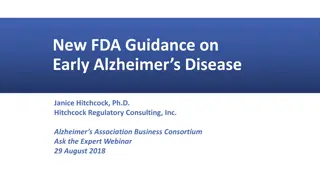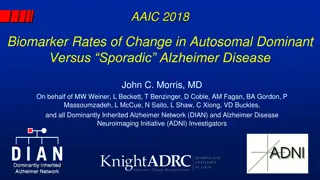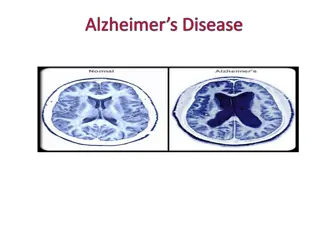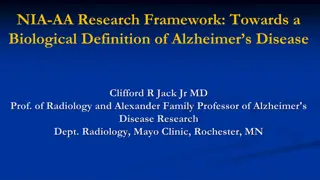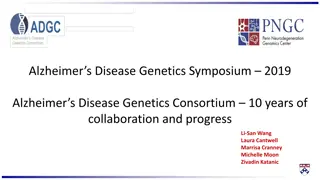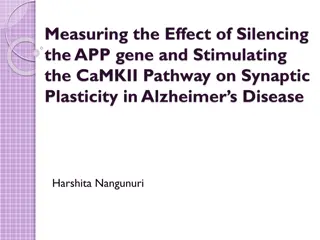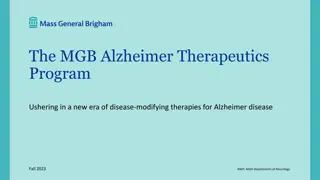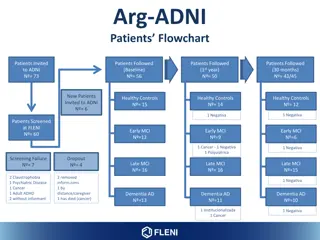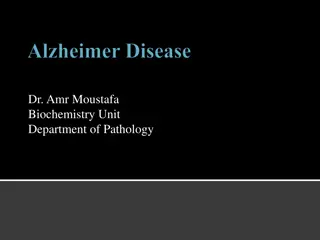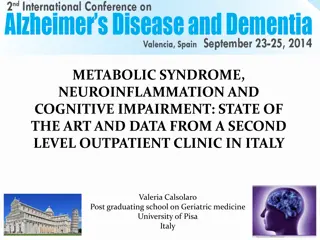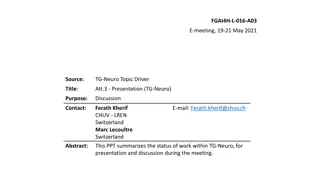Overview of Neurodegenerative Disorders: Alzheimer's Disease Pathophysiology
Diseases of gray matter involve progressive loss of neurons with development of cytotoxic protein aggregates, impacting cognitive function and leading to severe disability. Diagnosis typically involves clinical assessment, radiologic methods, and pathologic examination of brain tissue to identify characteristic abnormalities like neuritic plaques and neurofibrillary tangles.
Download Presentation

Please find below an Image/Link to download the presentation.
The content on the website is provided AS IS for your information and personal use only. It may not be sold, licensed, or shared on other websites without obtaining consent from the author.If you encounter any issues during the download, it is possible that the publisher has removed the file from their server.
You are allowed to download the files provided on this website for personal or commercial use, subject to the condition that they are used lawfully. All files are the property of their respective owners.
The content on the website is provided AS IS for your information and personal use only. It may not be sold, licensed, or shared on other websites without obtaining consent from the author.
E N D
Presentation Transcript
Dr. Usman Ghani CNS Block
Pathophysiology of alzheimers disease: http://www.youtube.com/watch?v=dj3GGDuu1 5I
Upon completion of this lecture, the students should be able to: Have an overview of neurodegenerative disorders Understand the role of amyloid beta 40-42 residue peptide in Alzheimer s disease Get an idea of the diagnosis and therapeutic approaches to treat these disorders
Diseases of gray matter characterized principally by the progressive loss of neurons The pattern of neuronal loss is selective affecting one or more groups of neurons leaving the others intact The diseases arise without any clear inciting event in patients without previous neurological deficits
A common theme is the development of protein aggregates that are resistant to normal cellular mechanisms of degradation The aggregated proteins are generally cytotoxic
A degenerative disease with the prominent involvement of the cerebral cortex Its principal clinical manifestation is dementia Dementia is the progressive loss of cognitive function independent of the state of attention Patients rarely become symptomatic before 50 yr. of age but the incidence of disease rises with age
The disease becomes apparent with: Gradual impairment of higher intellectual function Alterations in mood and behavior Progressive disorientation Memory loss In 5-10 yrs, the patient becomes profoundly disabled, mute and immobile Most cases are sporadic At least 5-10% are familial
Combination of clinical assessment and radiologic methods Pathologic examination of brain tissue is necessary for definitive diagnosis Major microscopic abnormalities include: neuritic plaques, neurofibrillary tangles and amyloid angiopathy
Spherical with 20-200 m in diameter Contain paired helical filaments as well as synaptic vesicles and abnormal mitochondria The amyloid core contains several abnormal proteins The dominant component of the plaque core is A , a peptide derived from a larger molecule, amyloid precursor protein (APP)
The two dominant species of A, called A40 andA 42 share an N-terminus and differ in length by two amino acids. Other less abundant proteins in the plaque: Components of the compliment cascade Proinflammatory cytokines 1-Antichymotrypsin Apolipoproteins
Bundles of filaments in the cytoplasm of neurons that displace or encircle the nucleus These filaments mainly contain: Hyperphosphorylated forms of the tau protein A protein that enhances microtubule assembly
Amyloid proteins build up on the walls of the arteries in the brain The condition increases the risk of hemorrhagic, stroke and dementia An almost invariable accompaniment of Alzheimer s disease but not specific for Alzheimer s
Still being intensively studied Strong correlation of number of neurofibrillar tangles with degree of dementia than neuritic plaques Biochemical markers correlated to degree of dementia include: Loss of choline acetyl transferase Synaptophysin immunoreactivity Amyloid burden
Loss of synapses best correlates with severity of dementia The A peptide forms -pleated sheets and aggregates Resistant to degradation Elicits a response from astrocytes and microglia Can be directly neurotoxic
Derived from the processing of APP APP is a protein of uncertain cellular function It is synthesized with a single transmembrane domain and expressed on the cell surface
-peptide (A ) TM Alpha-secretase pathway Beta-secretase pathway -stub -stub APPS APPS neurotrophic -secretase -secretase -secretase p3 A 40 A 42 neurotoxic
APP has potential cleavage sites for three distinct enzymes ( , , and -secretases) The A domain extends from the extracellular side of protein into the transmembrane domain When APP is cleaved by -secretase , subsequent cleavage by -secretase does not yield A
Cleavege by -secretase followed by - secretase results in production of A A can then aggregate and form fibrils
Accumulation of A protein affects neurons and neuronal function: Small aggregates of A alters neurotransmission Aggregates can be toxic to neurons and synaptic endings Larger deposits (plaques) also cause neuronal death Elicit a local inflammatory response leading to further cell injury
Presence of A causes hyper-phosphorylation of tau protein in neurons This leads to redistribution and aggregation of tau protein into tangles in neurons (from axon into dendrites and cell body) The process results in neuronal dysfunction and cell death
?? Factors that elevate A A Tau Fibril assembly Filament assembly Nerve cell mis- function and death? Nerve cell mis-function and death?
Mutations in APP gene Mutations in -secretase (presenilin-1 or presenilin-2) Both lead to early onset of familial Alzheimer s disease due to high rate of A accumulation Alzheimer s occurs in most patients with Down s syndrome (trisomy 21) beyond 45 years of age The gene encoding APP is located in chromosome 21 Due to APP gene dosage effects
Genes associated with typical, sporadic Alzheimer s disease are being identified This may provide new clues to pathogenesis of the disease
Chromosome 21 Gene Amyloid Precursor Protein (APP) Presenilin-1 (PS1) Consequences Early onset FAD Increased A production Early onset FAD Increased A production Early onset FAD Increased A production Increased risk for development of AD Decreased age at onset of AD 14 1 Presenilin-2 (PS2) 19 Apolipoprotein E (ApoE)
Currently no effective treatment for AD Regulating neurotransmitter activity (enhancing cholinergic function improves symptoms) Epidemiology shows NSAIDs decrease the risk for developing AD. Clinical trials of NSAIDs in AD patients are not very fruitful.
Polyphenols such as flavonoids reduce proinflammatory responses Flavonoid supplements may be a new therapeutic approach for AD
Stem cell therapy offers: Cellular replacement and/or provide environmental enrichment to attenuate neurodegeneration Neurotrophic support to remaining cells Prevent the production or accumulation of toxic factors that harm neurons
The small aggregates of A and larger fibrils are directly neurotoxic They can elicit oxidative damage and alterations in calcium homeostasis How A is correlated to neurodegeneration in AD? How it is linked to tangles and hyperphosphorylation of tau protein? All remain open questions
Neurodegeneration is progressive loss of structure and function of neurons including neuronal death Amyloid protein forms insoluble fibrous aggregates in neurons leading to Alzheimer s disease Deposition of amyloid interferes with normal cellular function resulting in loss of function and cell death The dominant component of amyloid plaque that accumulates in Alzheimer s disease is amyloid 42 (A 42) peptide
Illustrated Reviews of Biochemistry by Lippincott 4th edition (pp21-22 ). Fundamentals of Biochemistry by Voett and Voett (pp 170-174)






